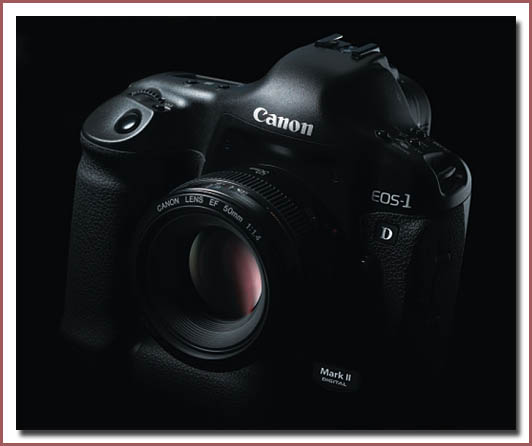
 |
Canon 1D MK II (January 29, 2004) |
 |
1. Introduction |  |
| 2. MK II Sensor.. | ||
| 3. 1D vs. 1D MK II |
On January 28, Nikon announced their response to the 300D (Digital Rebel to those in the US, but I like the name 300D better). The D70. The D70 has a larger buffer, same sensor as the D100, and even allegedly writes to media cards 3x faster than the D100 (and the D100 is fast on its own). The next day, Canon released their response to the D2h. It had 8.2 megapixels, and had a deep enough buffer to write 40 JPEG or 20 RAW files. But that wasn't the end of this new camera by Canon. Oh no. Did I forget to mention it could do all of these things at 8 frames-per second? Actually, according to Canon, 8.5 frames-per-second. I remember discussing these possibilities with friends--some of them giving a strong hint this camera was for real. I was telling myself, if Canon made such a piece of equipment, it would most likely sell for as much as their 1Ds--maybe more. Well, I was certainly mistaken. Both on price, and on capability. Canon surely has ruffled some feathers of their competition. To date, there is nothing else which can compete with its massive buffer and large resolution, including the fastest frames-per-second. Before we do move to the preview, you may wonder why Canon chose the "Mark II" name, and not some other name. Well, the answer is in a Canon Japanese press release on January 29, 2004. In it, Yukiaki Hashimoto (senior vice president and general manager of the consumer imaging group at Canon U.S.A) said: "Having made our mark on photojournalism, sports-action photography, portrait and wedding photography and the world of professional photography overall with the EOS-1D and 1Ds digital SLR cameras, Canon once again raises the standard of imaging excellence, efficiency and ease of use..." The Mark II is the second round of Canon's debut in these fields, making another mark in digital photography. This time, the mark takes a shot at both the sports photographer, and the studio photographer. |
|||||
Major New Features |
|||||
Let's take a look at some of the major features of the 1D MK II:
|
|||||
 |
1. Introduction |  |
| 2. MK II Sensor.. | ||
| 3. 1D vs. 1D MK II |